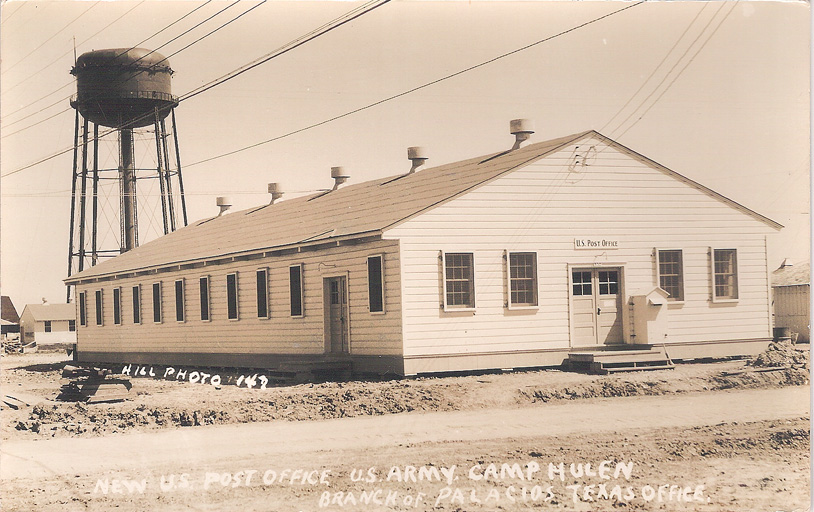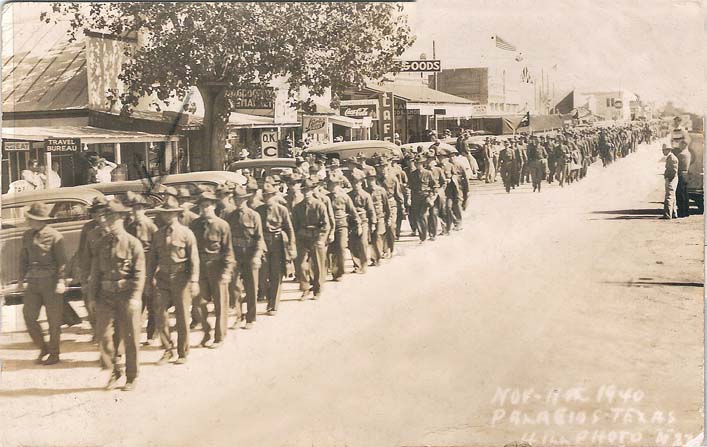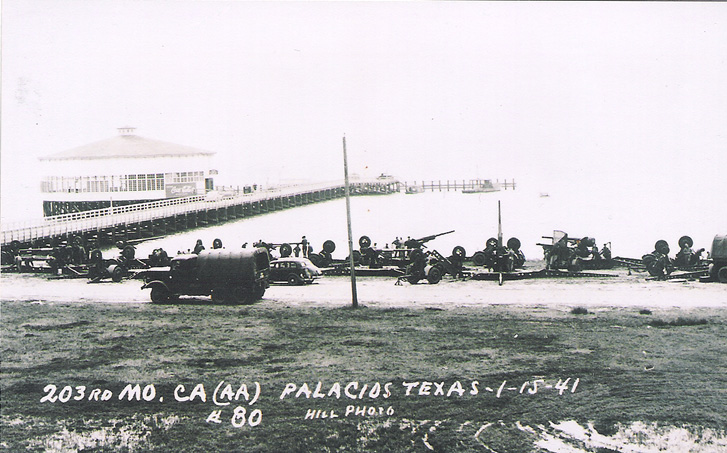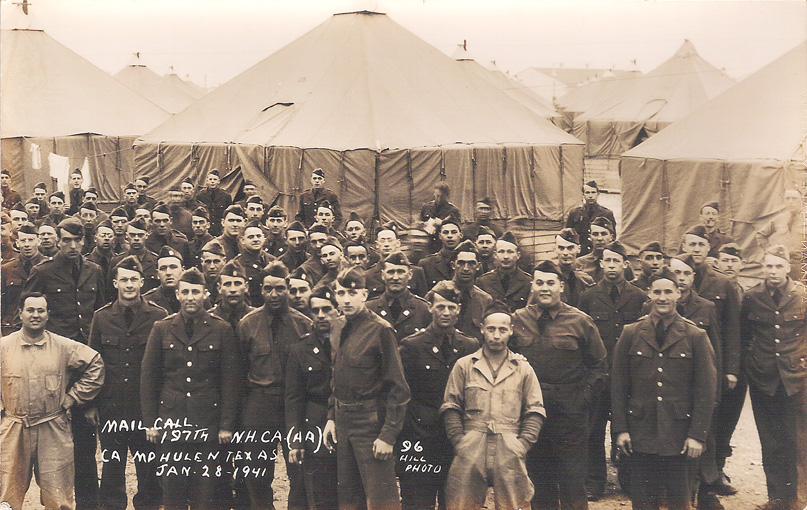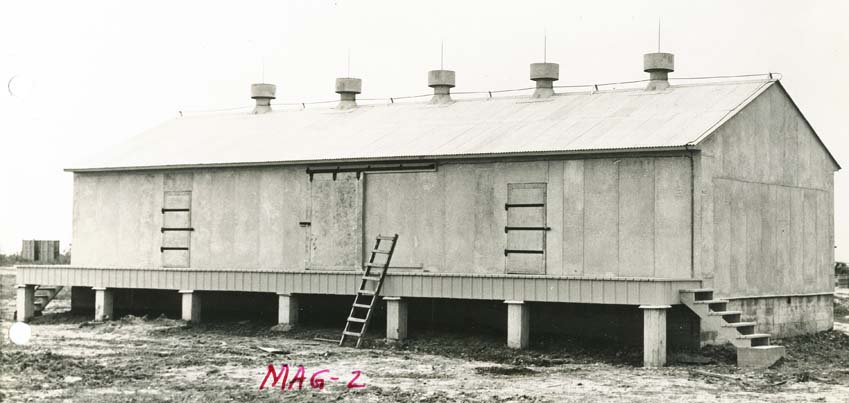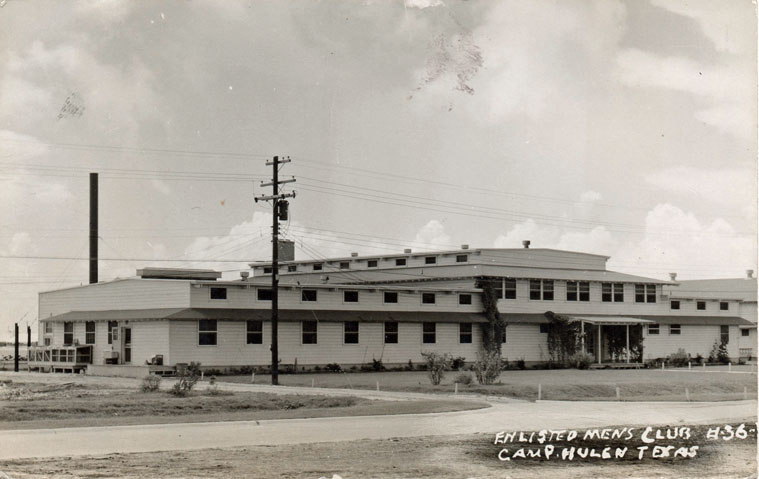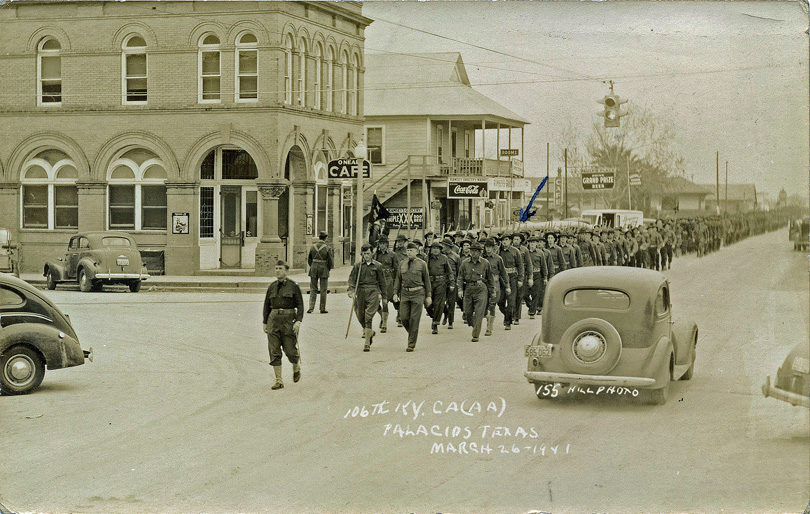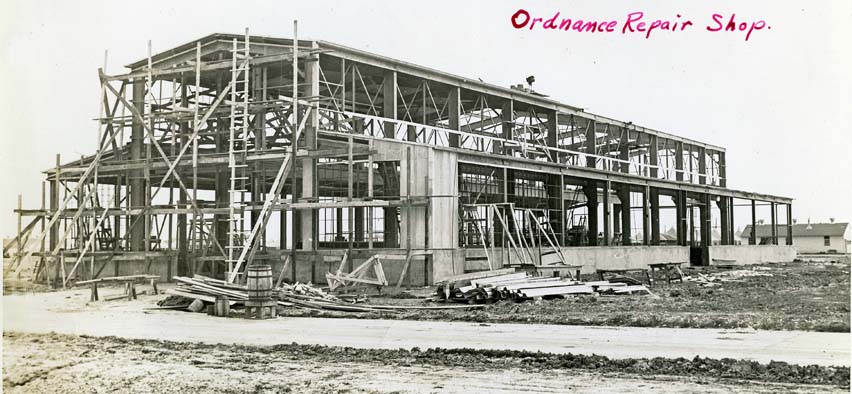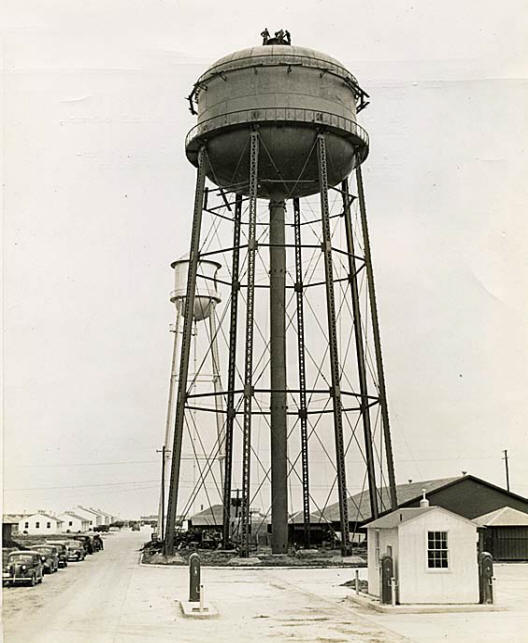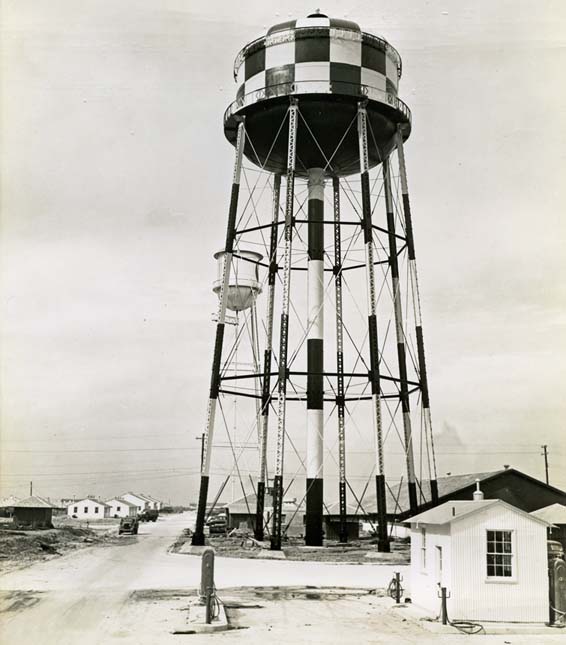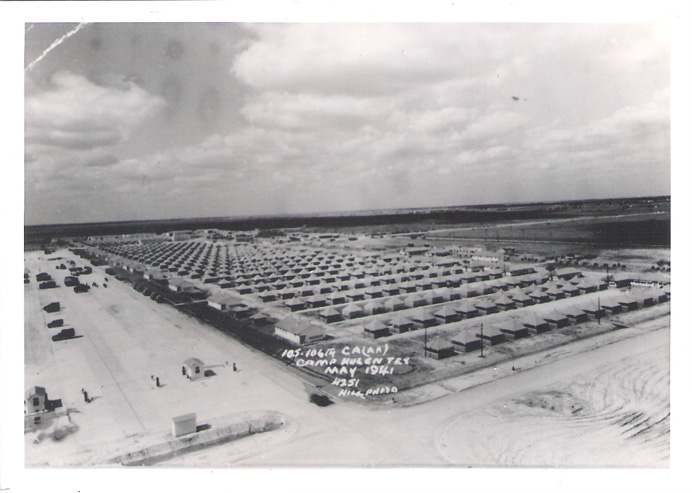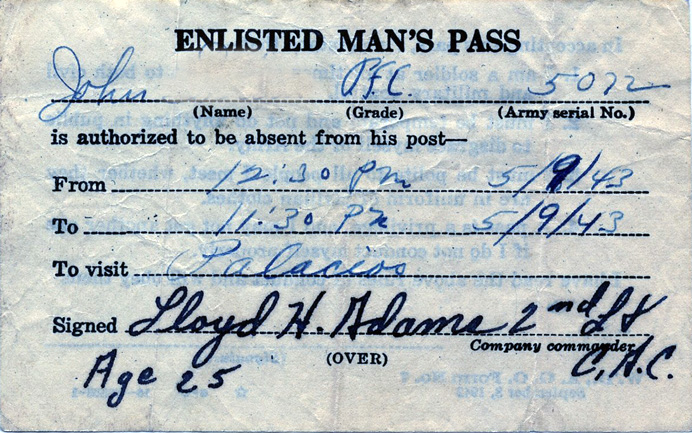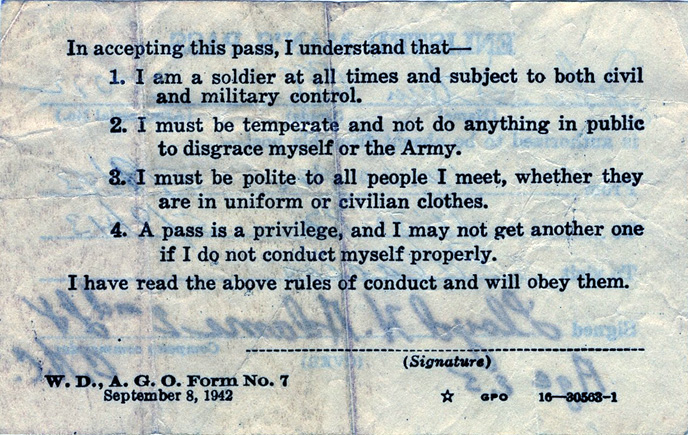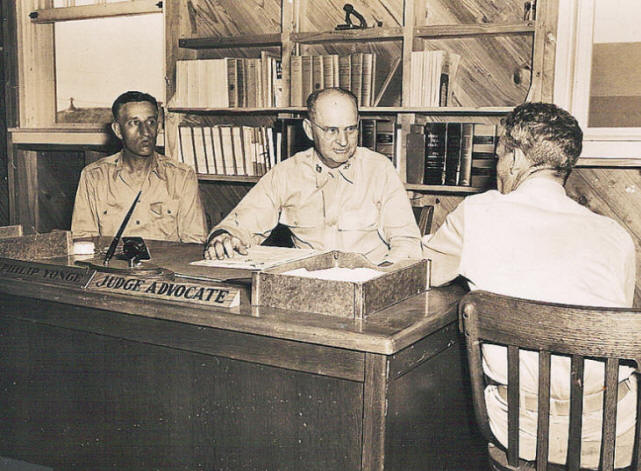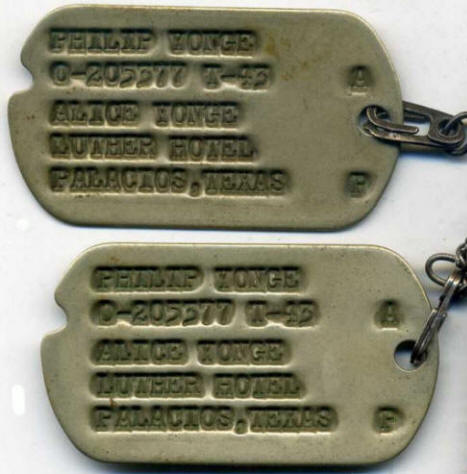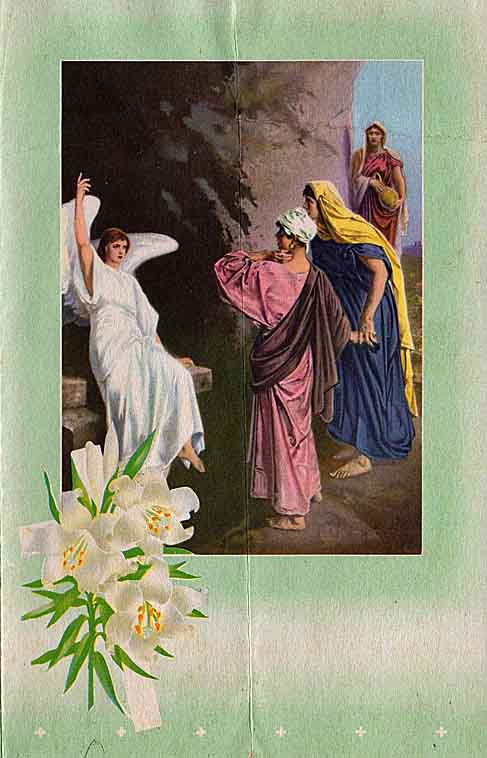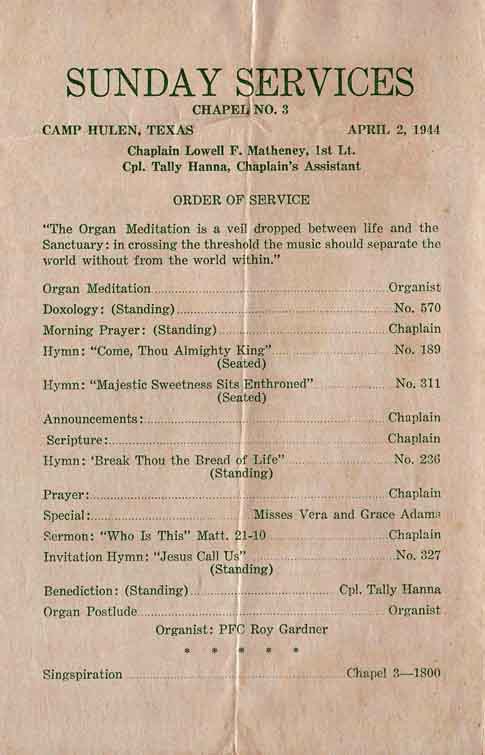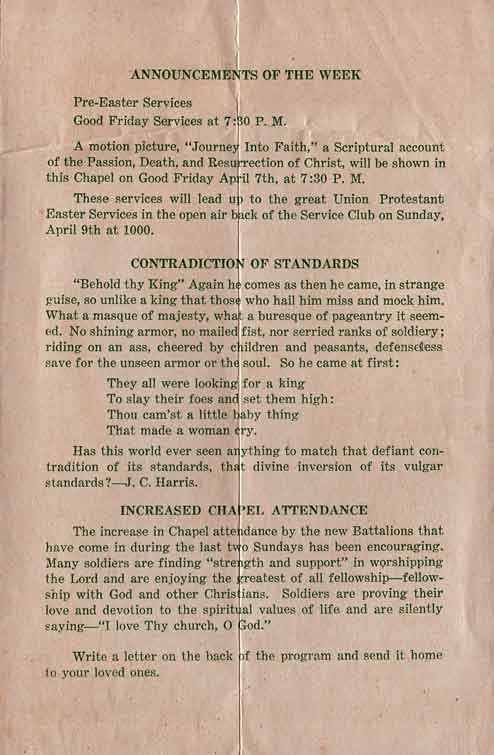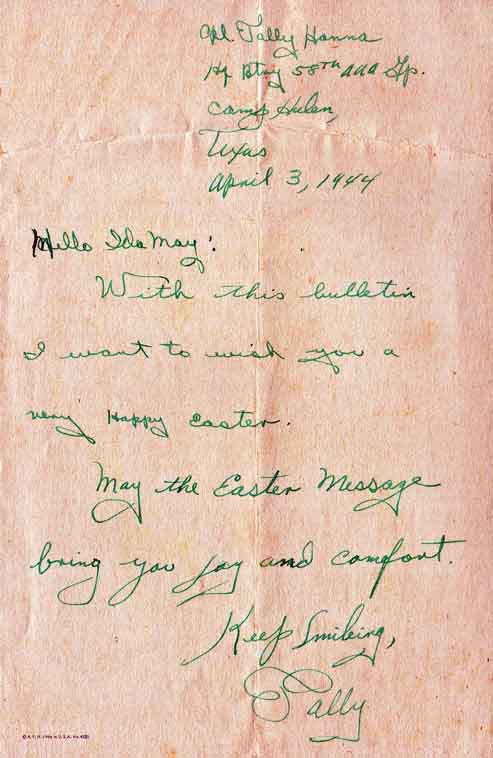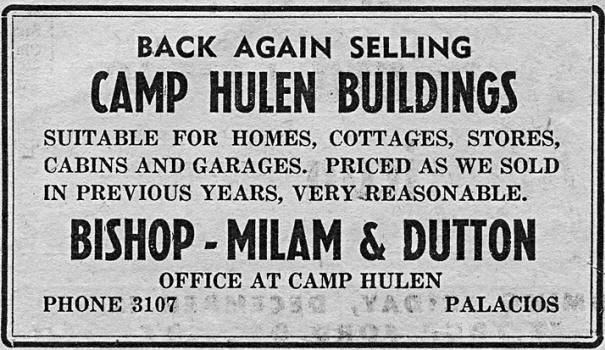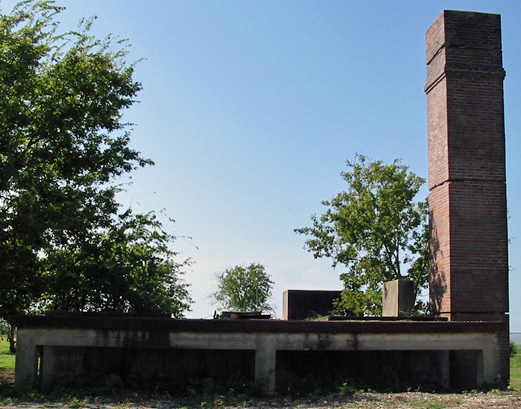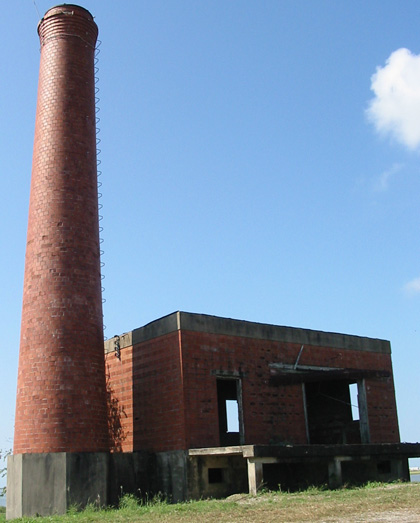|
Site of Camp Hulen W Main Street & Marine Center Drive 28°42’48.71”N 96°14'36.73"W |
||||||||
|
The Palacios Chamber of Commerce appointed a Citizens Committee composed of local business men, to work on details for bringing the camp to Palacios. Committee members were J. B. Barnett, Duncan Ruthven, R. J. Sisson, Carlton Crawford, W. C. Gray, C. W. Nester, J. L. Koerber, H. M. Sanders, Jas. W. Sartwelle, P. F. Campbell and H. A. Echols. Although several locations were available within the state, due to the climate conditions, availability of good artesian water and its proximity to water transportation, the T. N. G. and especially General Hulen favored a 1,200 acre site approximately one mile west of Palacios. The site consisted of twenty tracts, most of which were occupied as farms and homesites, which were substantially improved at the time, all of which had to be cleared out. The acreage had to be purchased and deeded to the state free with a good title. The Citizens Committee members worked almost full time soliciting funds and pledges for the purchase of the land. $30,000 was the original amount to be raised but it ended up being approximately $50,000. In November of 1924, General Hulen and several other officers of the 36th Division inspected the camp site and passed favorable on the location. Immediately after the inspection Adjutant General Thomas D. Barton recommended establishment of a national guard camp at Palacios, (population about 2,000) large enough to care for the annual training of 15,000 officers and men and including infantry, machine gun and artillery ranges. The recommendation was endorsed by the Eighth Army Corps Headquarters in San Antonio and forwarded to Washington for acceptance. Although the Citizens Committee had worked diligently on negotiations for the camp and raising the necessary funds, the detail work was voluminous and the responsibility so great that it could not be handled by a few. The Palacios Camp Site Association, Incorporated, was organized. The charter was granted by the State of Texas on April 30, 1925, and the directors were named from the original Citizens Committee, with such additional members necessary to carry out the plan. The War Department approved the camp site and authorized $68,000 for immediate improvements and a five-year improvement program with a total estimated cost of $307,000. The Southern Pacific Railroad Company agreed to construct terminal facilities at Palacios as would be needed for the handling of the division. Improvement work was to begin May 15, 1925, so that the division could train at the camp site in July of that year. The additional funds required were raised by the deadline with the help of all towns in Matagorda County plus El Campo and Danevang, but by June three important items remained to be done - correct the abstracts, finish the easements and procure the right-of-way for the railroad spur. Therefore, only the 111th Engineers of the division trained at Camp Palacios in July of 1925. The federal government announced plans to construct rifle and artillery ranges at the camp, which would assume importance as a unit of the national defense. All legal technicalities were completed and advertised bids for work to be done at Camp Palacios were opened on December 10, 1925, and contracts signed on December 21st. Contracts called for construction to begin on December 28, 1925, with a completion date set for June 1, 1926. Formal ground breaking ceremonies were held Monday, December 28, 1925. Because of the rain and sleet the ceremonies at camp were very simple, and many of the out-of-town visitors were unable to attend. General John A Hulen, Commander of the 36th Division, and General Jake Wolters, Commander of the 56th Cavalry Brigade, along with numerous other national guard officers were in attendance. Lt. Col. Claude A. Adams, U. S. Property & Disbursing Officer, threw the first spade of dirt. The first week in July, 1926, advanced detachments from all units of the 36th Division were encamped at Camp Palacios getting everything ready for the remainder of the division. On July 9, 1926, more than 6,000 men detrained at Camp Palacios, the largest assemblage of Texas troops ever in peace time, to begin 15 days of training. The legislature in session in September, 1926, was called upon to accept for the state 1,200 acres of land, to be used as a permanent camp site for the 36th Division, T. N. G. The land was deeded in trust to Major General John A. Hulen, Commander of the 36th Division, who in turn deeded it to the State of Texas. The land was donated by the people of Palacios and the site was now valued at $500,000. All expenditures for improvements were borne out of War Department funds and the site had cost the State of Texas nothing. In September of 1930, the War Department in Washington, D. C. announced that Camp Palacios had been renamed "Camp Hulen," in honor of Major General John A. Hulen, Commander of the 36th Division, Texas National Guard. By the 1930 encampment Camp Hulen held the largest concentration of troops for field training in the United States. It was the only division, either national guard or regular army, to train as a unit. The 36th Division held its annual training at Camp Hulen through 1939, except for 1938, when government regulations required that a general mobilization be held. Throughout those years the War Department continued to allocate funds for improvements. By 1938 over $600,000 had been spent on Camp Hulen. Improvements completed included 1,890 cement tent floors and more than 400 permanent buildings, all lighted by electricity. Streets had been graded and drained, sycamore trees and oleanders planted. In addition to the 36th Division, Camp Hulen was used by the national guard coast artillery units from Arkansas and Missouri, Marine Reserves, the 972nd Coast Artillery Anti-Aircraft of the Eighth Corps Area, the 69th Coast Artillery, a contingent from Brooks Field in San Antonio held their gunnery practice at the camp and 4-H Clubs of Brazoria, Matagorda and Wharton Counties. When anti-aircraft gun practice was scheduled, which took place over the bay, warnings to boatmen were published in the newspapers and posted on the post office bulletin board. In August of 1940, the War Department announced that Camp Hulen had been leased by the federal government to be used by Coast Artillery Anti-Aircraft units for at least one year. Between 8,000 and 9,000 men would be stationed at the site for a year of training. Ten National Guard Coast Artillery Anti-Aircraft regiments were called into federal service and five of those were scheduled to train at Camp Hulen. None of the five were from Texas. Three regiments (Missouri, Massachusetts and New Hampshire) arrived at Camp Hulen between September 23 and September 26, 1940 (4,500 men). By October there were 2,000 civilian workers getting the camp ready to handle 10,000 soldiers before January 1, 1941. The Palacios population in 1940 was 2,281. The influx of military and civilian workers had a profound impact on the town and its citizens. The town was visibly transformed in ways physical, psychological, economic and social. There was a dire housing shortage, numerous people lived in their cars using the rest rooms of the four gas stations, and there were many house trailers without sewer facilities. Temporary business shacks went up beside the established business houses, causing a real fire hazard as well as giving the downtown area an unsightly appearance. Prostitutes walked the streets endangering the health of both civilians and soldiers. The local law officials were so overtaxed with the amount of work put upon them that they could not curb all the vice in town. Working together, the Provost Marshal and camp surgeons of Camp Hulen, the Palacios Chamber of Commerce and medical organizations in surrounding counties took care of the health situation. A five-county military sanitary zone was set up; the zone included Matagorda, Wharton, Victoria, Jackson and Calhoun Counties. Just as construction got into "high gear," the rains came and Camp Hulen and the surrounding area became a sea of mud. Torrential downpours made life miserable for the soldiers and that is when Camp Hulen got its nicknames; "Lake Hulen" and "Swamp Hulen." The seas of mud hampered but did not slow the work being done to prepare the camp for the additional thousands of troops to be stationed there. Pictures showing the lakes of water and mud that covered roads and work areas were sent to Washington and caused considerable perturbation; they feared an extensive delay in construction would necessitate a similar delay in the complex training under the National Defense Program. The fears were groundless as work progressed according to schedule. All work included in the original program which called for an expenditure of $2,000,000 would be completed by December 1st and the expanded program calling for $2,000,000 would be ready by February 1, 1941. When completed, Camp Hulen had all the facilities for a modern and up-to-date city of 12,000 or more inhabitants. Sewage, water, gas, electricity, telephones, hospital for 500 patients, roads, chapels, bakeries, laundry, fire houses, warehouses, railroads, two motion picture theaters-one with a stage, Post Office (opened March 1, 1941), newspaper (Searchlight), motor garages, recreational buildings, service clubs, guest house and all other necessities of a city that size.
New U. S. Post Office, U. S. Army, Camp Hulen, Branch of Palacios,
Texas Office A 10-foot non-climbable fence was installed to surround the entire camp, with flood lights at frequent intervals. WAR! Within three days of Pearl Harbor, December 7, 1941, Camp Hulen was depopulated by possibly more that half of its military personnel. (Units, destination and the number of troops a military secret.) Although the camp population dropped by a large number during these three days, some troops remained and additional trainees arrived. Camp Hulen continued to be used as a Coast Artillery Anti-Aircraft training site, but in the interest of national security, very little information was available as to what was going on in the camp. Due to anti-aircraft training, most all waters in the area were included in the "Danger Zone Regulations." No boats were permitted to enter the restricted area from 8:00 a.m. to 6:00 p.m. on all week days without obtaining clearance from the Anti-Aircraft Training Center Headquarters in Camp Hulen. Camp Hulen prisoner of war camp was established on November 11, 1943, as a branch of Hearne POW camp but became an independent camp February 15, 1944. It was rather small for a base camp, having a capacity of only 250 German POWs. Late in 1944, plans were considered for converting all the facilities at Camp Hulen to a prisoner of war camp. The basic plan called for Hulen to be vacated of American troops, and the anti-aircraft facilities closed and moved to another base. Then the entire base would be converted to a POW camp capable of holding 14,800 prisoners. Although plans were drawn up to accomplish this end and the capacity was temporarily expanded, the huge influx of POWs to the Hulen facility never materialized. Instead, the number of POWs there averaged only about 250 until the prison camp was closed in September 1945. Documentation has not been located, but it has been said that the above plans were not carried out because it would have been too difficult to control the large body of prisoners. Although there had been no major problems with the Hulen prisoners, other POW camps had experienced beatings and even killings of prisoners by fellow prisoners. In July, 1945, Camp Hulen's population had dwindled to about 100 military men, 200 prisoners and some civilians. The camp was, however, kept in readiness to be reopened on 24-hour notice in case of an emergency. There were no emergencies. Effective midnight September 30, 1946, Camp Hulen which had been leased by the War Department for the past six years, was returned to the state and the Texas National Guard was once again in charge of it. National Guard units were rapidly being organized and Palacios citizens were hoping to see Camp Hulen used again for annual guard training. In 1948 a seventeen year struggle began. Palacios citizens wanted the camp put into use again and the Palacios Chamber of Commerce appointed a committee (Dr. Leroy Wilcox, Eli Mayfield and Mayor Glenn Claybourn) to confer with General Hulen in regard to sending a wire to Adj. Gen. Berry at Austin, expressing the desires and wishes of the people of Palacios in regards to the sale of or disposal of Camp Hulen. For the next several years the highway, long distance telephone and wire service were kept busy with travel and communications between Palacios and Austin. Some felt the land should be returned to the people of the area by gift - the same way the state originally acquired it - but the constitution definitely ruled out any form of gift, in whole or in part, with no consideration of how the state acquired the property. Washington had informed Adj. Gen. R. L. Berry that Camp Hulen would never again be used by the United States Army, the camp was too small for the National Guard, it was costing the State of Texas some $20,000 a year to maintain the camp and General Berry believed that more good could be obtained for the people of Matagorda County and Texas, if the camp was sold. Citizens of Palacios and surrounding territory, led by the Palacios Chamber of Commerce, along with General Berry, were instrumental in securing the passage of House Bills 13 and 448. (Signed by Governor H. Jester on May 21, 1949.) Passage of the bills enabled the Adj. General of the State of Texas to declare Camp Hulen surplus to that such properties could be sold in the manner provided by law. In December of 1949 Joe Tafallo, Retired Army Major, was employed as Officer in Charge of Camp Hulen to oversee the selling off of the Hulen buildings. Tafallo and his family were the only occupants of Camp Hulen. The sale of buildings began in 1950. Buildings were each assigned a number and at regular intervals various groups of buildings were advertised for bids. It was finally agreed that the State of Texas would sell the camp site to the Appelt, Robeau and Balch, Inc., industrial real estate developers, and the citizens of Palacios. Underwriting the project for the citizens were Mrs. G. A. Harrison, George L. Harrison, I. T. Petersen, Herman Bond, R. B. Trull, J. Fred Huitt, J. P. Mattox and Eli Mayfield. The sale was as per Senate Bill No. 95, 57th Legislature, Third Called Session. Briefly, this bill stated that the State of Texas appointed the governing body of the City of Palacios as its agent for the purpose of selling or leasing the property in whole or in part as an industrial site, (The restriction, only for industrial use, was later dropped.) at a fair and reasonable market price. The city to collect 10% of the sale price as agent. The Adjutant General's Department approved the offer of $299,405 as total price for the Camp Hulen site. In August, 1965, title to the camp site was approved and the land became available for purchase. Capital needed was $62,500, the amount to be raised by Palacios citizens. The remaining balance was raised by the Industrial Developers of Houston. Any Palacios citizen could contribute to the $62,500 as a limited partner. $1,250 per share was the minimum for each person. A maximum of 20 persons, in addition to the original nine subscribers, were allowed to participate. The transfer of 1,199 acres in Camp Hulen was completed on Monday, October 18, 1965, with the transaction taking place in the office of Attorney General Wagoner Carr. On the receiving end of the acreage was the Palacios Industrial Development Company, Ltd. Present for the transfer were General Bishop and General Scott of the Texas National Guard and Colonel Kelton, Executive Director of the Armory Board and representatives of the Palacios company. The Armory Board received a total of $269,464.50, and the City of Palacios, as agent, received $28,630.50. As of 1996, all that remained at the Camp Hulen site were traces of some old building foundations, concrete auto repair pit, brick smoke stacks from the insinuator, concrete boulevards and streets, asphalt runways, shrubs, trees and some Oleander bushes along the southeast property line. The acreage is currently leased for cattle grazing. GENERAL JOHN A. HULEN John Augustus Hulen was born in Centralia, MO., September 9, 1871. His family moved to Texas in 1873. He was educated in public schools in Gainesville, Staunton Military Academy in Victoria, Texas, and Marmaduke Military Academy in Sweet Springs, Missouri, where he graduated in 1891. He married Frances L. Race on February 14, 1893. General Hulen served his country in the Spanish-American War, the Philippine Insurrection, against Pancho Villa, in World War I, and as Commander of the 36th Division of the Texas National Guard from 1919 until his retirement in 1935. His bravery in action won him the French Croix de Guerre twice, the American Silver Star and Distinguished Service Medal. Between periods of military service, General Hulen had a long and distinguished railroad career that included chairman of the board of the Burlington-Rock Island Railroad. |
||||||||
Camp Palacios was established on this site in 1925 as the summer
training camp for the 36th Infantry of the Texas National Guard. Located
on the Turtle and Tres Palacios Bays, the land was donated by Palacios
area citizens. Over 6,000 guardsmen arrived in July of 1926 for the
first training session. Renamed for Major John A. Hulen (1871-1957) in
1930, the new camp supported the largest concentration of troops for
field training in the United States military. In 1940 the War Department
leased Camp Hulen; first to undergo anti-aircraft training were National
Guard units from several states. By 1941 the city of Palacios suffered a
housing shortage that was alleviated by government housing near Camp
Hulen. After extensive development the camp had facilities for 12,000
military personnel. Basic training continued until early 1944 when U.S.
soldiers were removed. German prisoners of war, guarded by a small
contingent of U.S. personnel, were housed here from 1943 to 1945. In
1946, the War Department returned Camp Hulen to the National Guard, for
whom it had become too small, buildings were slowly dismantled and sold.
In 1965 the property was sold jointly to a group of Palacios citizens
and a development company. (1997) |
||||||||
|
A large crowd, including visitors from all points in the state, attended
the dance at the Officer's Club, Camp Hulen, Saturday evening given by
the artillery regiment. Among those present were
Matagorda County Tribune, August 13, 1936 |
||||||||
|
|
||||||||
|
|
||||||||
|
|
||||||||
|
|
||||||||
|
|
||||||||
|
|
||||||||
|
|
||||||||
|
|
||||||||
|
|
||||||||
Officer Promoted Lamesa, Mar. 29.--Philip Yonge, county judge of Dawson county, and adjutant of the Allen-Houston Post of the American Legion in Lamesa was notified this week of his promotion from a lieutenant to captain in the Judge Advocate General's department of the reserve corps. Abilene Reporter, March 30, 1930 Promotion To S'water Lawyer Sweetwater, Aug. 19--Promotion of Philip Yonge, former Sweetwater attorney, to the rank of lieutenant colonel on the judge advocate staff at Camp Hood was announced recently. Colonel Yonge was a member of the law firm of Beall, Beall & Yonge here for more than five years before he went into service in December, 1942. He came to Sweetwater from Lamesa in 1937, and was county judge of Dawson county from 1930 until 1937. He was reared at Post, and served two years in the Army during World War one. He had held a reserve commission since 1926. Colonel Yonge and his wife have an apartment in Temple, but she is spending the summer at a cabin in Taos, N. M. His niece, Jane Moore of Sweetwater, daughter of Mr. and Mrs. Dalton Moore, is with her there. Colonel Yonge has been spending a 15-day leave with them. Yonge has been at Camp Hood since the fall of 1943. He was first stationed at Camp Hulen. Abilene Reporter, August 20, 1945 Colonel Returns to Law Practice Sweetwater--After three years' service as a judge advocate in the army. Lt. Col. Philip Yonge, has returned to his law practice in Sweetwater following his discharge Thanksgiving day. He is a member of the law firm of Beall & Yonge. Colonel Yonge served two years in World War I and went into service in World War II as a reserve captain on Dec. 3, 1942. He was first assigned to the judge advocate's office of the Eighth service command in Dallas, and later was transferred to Camp Hulen at Palacios as staff judge advocate. He was transferred in Oct. 1943, to the Tank Destroyer Center at Camp Hood as staff judge advocate and remained there until his discharge He was promoted to lieutenant colonel in July. Mrs. Yonge has been living in Temple to be near him. Before coming to Sweetwater as a member of the Beall law firm in 1937, Colonel and Mrs. Yonge lived in Lamesa and he was county judge of Dawson county from 1930 to 1937. He was reared in Post. He had held the reserve commission since 1926. Colonel and Mrs. Yonge have already reoccupied their home at 1008 Woodruff Lane. Col. Wm. Cummings, commanding officer at Avenger Field and his wife have been living there. Abilene Reporter, December 2, 1945 Sweetwater Jurist, Philip Yonge, Dies Sweetwater, Nov. 13. (RNS)--Funeral for Philip Yonge, 60, Sweetwater attorney and former Dawson County judge, will be held at 10 a. m. Monday in St. Stephens Episcopal Church here. Mr. Yonge died at 1:15 a. m. Friday in the Veterans Hospital at Big Spring where he had been a patient four months. He was a veteran of both World Wars. Mr. Yonge was a brother of Jack Yonge, Abilene automobile dealer. He had been a member of the law firm of Beall, Beall and Yonge here since 1937. During two years of service in World War I he was stationed at Fort Sam Houston and on being released from service practiced law with his father at Post. In 1924 he became associated with the firm of Garland and McGuire of Lamesa. Mr. Young was married to the former Miss Alice Hudson of Farmersville, a teacher in Post, May 10, 1924 and they established their home in Lamesa. In January, 1930, he was appointed Dawson County judge, a post he held until 1937 when he moved to Sweetwater. Having held an Army reserve officer's commission since 1924, he was recalled to military duty in December, 1942, as a captain in the judge advocate general's department of the Army. First assigned to the Eighth Service Command at Dallas, he was later transferred to Camp Hulen at Palacios as camp judge and in October, 1943 was transferred to Camp Hood as staff judge. He remained there until his discharge from service as a lieutenant colonel in November, 1945. Survivors include his wife; his mother, Mrs. Arthur Yonge, Sr., of Baird; three brothers, Jack of Abilene; Arthur, Jr., of Lubbock and Charles of Longview; four sisters, Mrs. Dalton Mocre of Sweetwater; Mrs. Frank Myers of Waco, Mrs. H. W. Arnett of Hugo, Okla., and Mrs. Mable German of Lubbock. The Rev. H. G. Purrington, Episcopal church rector, will conduct final rites here and burial will be in Elmwood Memorial Park in Abilene. Pallbearers will be Carlos Mortis, H. S. Biggerstaff, Dent Beall, Leland Glass, Willis Davis, Bill Carson, John Miner and Charles Griggs.
Abilene Reporter, November 14, 1953 |
||||||||
|
||||||||
|
It is generally rumored that Camp Hulen, for many years an antiaircraft training center, will be used as a prisoner of war camp. The camp has been rapidly depleted of personnel in the past several weeks, until it now has but a skeleton force. The last battalion left the camp this week. For years there have been repeated rumors on every turn, as to the future of the camp. As far back as 1942 there were rumors that the camp would close. In fact rumors were so numerous in Bay City and Palacios that the camp commanders facetiously stated they found out more about the camp from Palacios and Bay City than from the War Department. But it now seems definite that the camp will be used as a prisoner of war camp and many thousands of prisoners will be interned there. Camp Hulen was constructed as an antiaircraft training center from the National Guard encampment grounds way back in 1940 and the first national guardsmen from New Hampshire, Massachusetts, Missouri, came here at that time. Since then hundreds of thousands of troops have gone through the camp.
Daily Tribune, November 22, 1944 |
||||||||
|
Bids have begun to pour in for the purchase of approximately 2400 buildings that are being offered for sale at Camp Hulen. The buildings which are fabricelotex hutments ranging in size from 16' x 16' to 20' x 144' and containing from 600 to 5,000 board feet of lumber are being offered for sale to the highest bidder. Anyone may bid on the buildings and may buy either one or more buildings, or may buy the buildings in blocks of from 13 to 26. The buildings that are being offered for sale have many uses, they may be used for camp cabins, tenant houses, storage houses, garages, or may be converted into homes by putting two or three together and remodeling them to suit one's needs. Many of the bidders plan to remove the celotex siding from the buildings and shingle them with asbestos shingles and use the celotex for inside sheathing, which will if painted on the inside make nice clean livable quarters. These buildings which have quite low salvage values can be moved very easily because they are bolted down to concrete slabs and may be raised by removing a few bolts and either moved intact or dismantled and moved in sections at very little cost. The buildings are open for inspection to all prospective bidders 7 days a week until the morning of the bid opening. Representatives of the government are on hand to assist all prospective bidders with the bidding. Bid forms are available to all prospective bidders at the Post Engineers office, Camp Hulen, Texas, or may be obtained from the Division Real Estate Bank Building, 430 Lamar Street, Houston, Texas. Prospective bidders are urged to submit their bids early and are invited to attend the bid opening which will be held here at Camp Hulen at 10:30 A. M. June 25, 1947
Palacios Beacon, June 19, 1947 |
||||||||
|
|
||||||||
|
Members of the Danevang community, without a church building since the 1940 hurricane destroyed it, have purchased from the WAA, one of the chapels at Camp Hulen. A committee, with V. A. Petersen as president, was appointed to investigate and made the purchase. The chapel will be moved from Camp Hulen to Danevang and placed on a site west of the Community House.
Palacios Beacon, July 10, 1947 |
||||||||
|
Palacios Beacon, December 4,
1952 |
||||||||
|
||||||||
|
|
||||||||
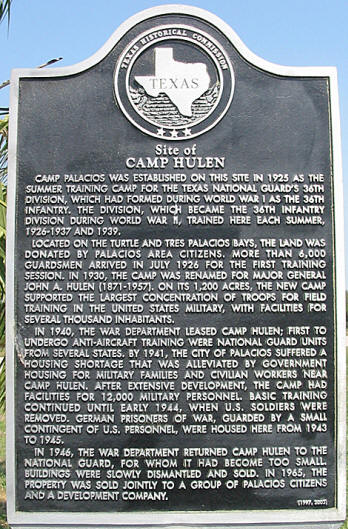 In 1924 the 36th Division of the Texas National
Guard numbered 7,205 officers and enlisted men commanded by Major
General John A. Hulen (1871-1957), with 957 officers and men in the
Fifty-sixth Cavalry Brigade under General Jacob F. Wolters. For the
past half century the Texas troops had held their annual training
encampment at Camp Mabry, Austin, but the site had been outgrown for
several years. Because of the prohibitive cost of land near Austin
it was not feasible to expand Camp Mabry. The Texas National Guard
was looking for a 1,200 acre camp site with an additional 15,000
acres that could be used for drill and maneuvers during encampments.
In 1924 the 36th Division of the Texas National
Guard numbered 7,205 officers and enlisted men commanded by Major
General John A. Hulen (1871-1957), with 957 officers and men in the
Fifty-sixth Cavalry Brigade under General Jacob F. Wolters. For the
past half century the Texas troops had held their annual training
encampment at Camp Mabry, Austin, but the site had been outgrown for
several years. Because of the prohibitive cost of land near Austin
it was not feasible to expand Camp Mabry. The Texas National Guard
was looking for a 1,200 acre camp site with an additional 15,000
acres that could be used for drill and maneuvers during encampments.